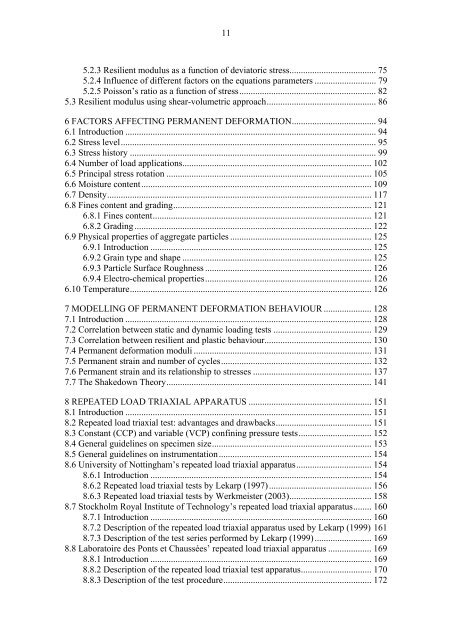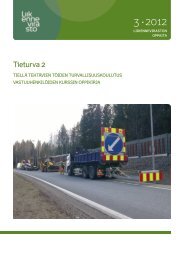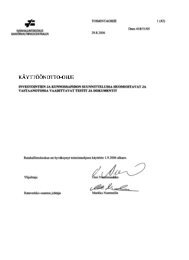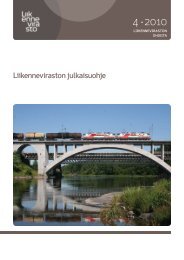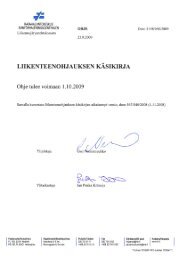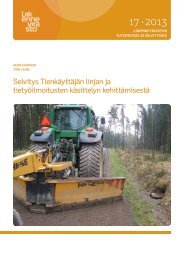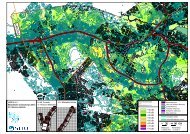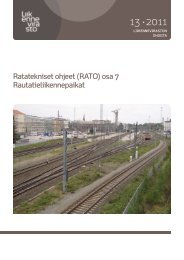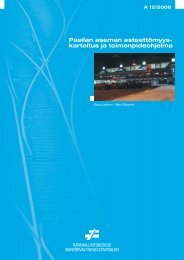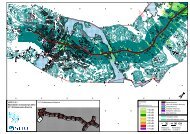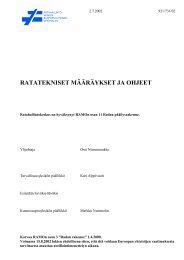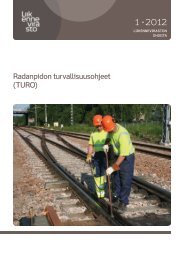Deformation behaviour of railway embankment ... - Liikennevirasto
Deformation behaviour of railway embankment ... - Liikennevirasto
Deformation behaviour of railway embankment ... - Liikennevirasto
You also want an ePaper? Increase the reach of your titles
YUMPU automatically turns print PDFs into web optimized ePapers that Google loves.
11<br />
5.2.3 Resilient modulus as a function <strong>of</strong> deviatoric stress...................................... 75<br />
5.2.4 Influence <strong>of</strong> different factors on the equations parameters ........................... 79<br />
5.2.5 Poisson’s ratio as a function <strong>of</strong> stress............................................................ 82<br />
5.3 Resilient modulus using shear-volumetric approach................................................ 86<br />
6 FACTORS AFFECTING PERMANENT DEFORMATION..................................... 94<br />
6.1 Introduction .............................................................................................................. 94<br />
6.2 Stress level................................................................................................................ 95<br />
6.3 Stress history ............................................................................................................ 99<br />
6.4 Number <strong>of</strong> load applications................................................................................... 102<br />
6.5 Principal stress rotation .......................................................................................... 105<br />
6.6 Moisture content..................................................................................................... 109<br />
6.7 Density.................................................................................................................... 117<br />
6.8 Fines content and grading....................................................................................... 121<br />
6.8.1 Fines content................................................................................................ 121<br />
6.8.2 Grading ........................................................................................................ 122<br />
6.9 Physical properties <strong>of</strong> aggregate particles .............................................................. 125<br />
6.9.1 Introduction ................................................................................................. 125<br />
6.9.2 Grain type and shape ................................................................................... 125<br />
6.9.3 Particle Surface Roughness ......................................................................... 126<br />
6.9.4 Electro-chemical properties......................................................................... 126<br />
6.10 Temperature.......................................................................................................... 126<br />
7 MODELLING OF PERMANENT DEFORMATION BEHAVIOUR ..................... 128<br />
7.1 Introduction ............................................................................................................ 128<br />
7.2 Correlation between static and dynamic loading tests ........................................... 129<br />
7.3 Correlation between resilient and plastic <strong>behaviour</strong>............................................... 130<br />
7.4 Permanent deformation moduli .............................................................................. 131<br />
7.5 Permanent strain and number <strong>of</strong> cycles.................................................................. 132<br />
7.6 Permanent strain and its relationship to stresses .................................................... 137<br />
7.7 The Shakedown Theory.......................................................................................... 141<br />
8 REPEATED LOAD TRIAXIAL APPARATUS ...................................................... 151<br />
8.1 Introduction ............................................................................................................ 151<br />
8.2 Repeated load triaxial test: advantages and drawbacks.......................................... 151<br />
8.3 Constant (CCP) and variable (VCP) confining pressure tests................................ 152<br />
8.4 General guidelines on specimen size...................................................................... 153<br />
8.5 General guidelines on instrumentation................................................................... 154<br />
8.6 University <strong>of</strong> Nottingham’s repeated load triaxial apparatus................................. 154<br />
8.6.1 Introduction ................................................................................................. 154<br />
8.6.2 Repeated load triaxial tests by Lekarp (1997)............................................. 156<br />
8.6.3 Repeated load triaxial tests by Werkmeister (2003).................................... 158<br />
8.7 Stockholm Royal Institute <strong>of</strong> Technology’s repeated load triaxial apparatus........ 160<br />
8.7.1 Introduction ................................................................................................. 160<br />
8.7.2 Description <strong>of</strong> the repeated load triaxial apparatus used by Lekarp (1999) 161<br />
8.7.3 Description <strong>of</strong> the test series performed by Lekarp (1999)......................... 169<br />
8.8 Laboratoire des Ponts et Chaussées’ repeated load triaxial apparatus ................... 169<br />
8.8.1 Introduction ................................................................................................. 169<br />
8.8.2 Description <strong>of</strong> the repeated load triaxial test apparatus............................... 170<br />
8.8.3 Description <strong>of</strong> the test procedure................................................................. 172


